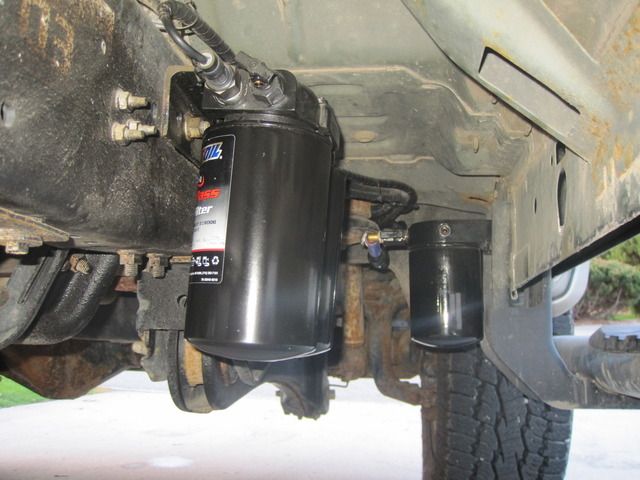A good case study on oil bypass filtration was done by the Idaho National Laboratory for the U.S. Department of Energy's Vehicle Technologies Office. Eleven full size diesel buses and six gasoline equipped Tahoes were used. Very interesting read. Go to http://avt.inel.gov/obp.shtml
You are using an out of date browser. It may not display this or other websites correctly.
You should upgrade or use an alternative browser.
You should upgrade or use an alternative browser.
Bypass wizards check in, Cat 1R-0749
- Thread starter cummins67man
- Start date
- Status
- Not open for further replies.
Originally Posted By: zpinch
Nice video, nice setup too. What FF filters are you using? What thread do they have on the? EAO26?
Thanks, I'm using the dual EaBp100's with a thread size of 1.000"-16 TPI. I believe the Ea026 is a a standard full flow filter thread size 3/4-16 in. I also installed the .094 restrictor disk on the outlet side of the filter housing as the dual housing have no Restrictors.
Nice video, nice setup too. What FF filters are you using? What thread do they have on the? EAO26?
Thanks, I'm using the dual EaBp100's with a thread size of 1.000"-16 TPI. I believe the Ea026 is a a standard full flow filter thread size 3/4-16 in. I also installed the .094 restrictor disk on the outlet side of the filter housing as the dual housing have no Restrictors.
Originally Posted By: tonyz
Nice and clean setup. I like the way you tucked it under the truck.
Thanks, I had to do that as the engine bay has no room for these filters. Makes it easy to change filters and take oil samples
Nice and clean setup. I like the way you tucked it under the truck.
Thanks, I had to do that as the engine bay has no room for these filters. Makes it easy to change filters and take oil samples
- Joined
- Jul 11, 2014
- Messages
- 4,118
IMO, .094 orifice is too big for domestic pickup engines. I'd try a .05 - .06 orifice ... Another option would be an inline check valve to prioritize oil flow to the engine. Parker c-series 5 or 10-psi check valve can be added to the oil source of any standalone bypass.
For the parallel setup, Amsoil kept it simple. Nothing to force oil thru the bypass other than full flow filter resistance. Nothing to worry about.
For the parallel setup, Amsoil kept it simple. Nothing to force oil thru the bypass other than full flow filter resistance. Nothing to worry about.
dnewton3
Staff member
Originally Posted By: carock
Originally Posted By: dnewton3
Originally Posted By: dnewton3
carock said:Nope - does not prove what you believe it does. If you think these are good evidence, then I ask you to give direct, specific citation (page and paragraph) so that I can counter your points.
NONE of those studies compares/contrasts how one properly managed system performs relative to the alternative. All these studies you folks point to are one-sided; they only study how things are viewed relative to the manipulation of the criteria for the bias of the bypass system.
I have yet to see one single study that shows how a typical FF system (managed to its best result) compares/contrasts to a BP (also managed to its best result), in moderate OCIs.
710813 - Pages 12 Figures 23 and 24 compares FF to FF and BP actual on the highway, no loaded sumps, real oil, normal OCI, of dump trucks over 120,000 miles. Read the article carefully, they almost sneak this test in as an afterthought. "Also included in these test data are comparisons with the wear obtained in the truck test using the 40 micron full flow filter and the 40 micron full flow filter in combination with the bypass filter. The results of the truck test with no intentional contaminant fed to the engine crankcase showed definite reduction in all engine component wear, but the percentage reduction was less than the dynamometer tests."
840453 - Figure 7 "Road Test With Standard Filtration Compared to Double Filtration " meaning FF to FF & BP. This compares the actual measured wear rates of road going delivery trucks with no special treatment to the oil. Wear is reduced around 50%.
902238 - Figure 7 FIlter "C" is the FF & BP combination with a 3 micron bypass. Notice wear is less than 50% of the 20 micron FF "B" and about 10% of the 40 micron FF "A". Read the whole article carefully. The 3 micron filter is a bypass filter, not a full flow filter.
"Bypass filtration, when used in conjunction with full flow filtration, provides an additional level or protection in terms of further reduced particle concentrations". The particle concentrations they are talking about are wear metals determined by full particle counts of each metal.
These articles all have real world tests in real world trucks with no loading the sump with abrasives and regular OCI's. They all have similar results. If this isn't proof what is? I have even more convincing tests from filter manufacturers, but they sell the things.
I will explain this one last time and then I'm going to exit ...
These studies (at least some of them) have practically no value. Others do some have some credible data, but not in context of this discussion.
Those studies you speak of do NOT address the concept of normal data and variance.
YES, FOLKS, I DO REALIZE THAT FINER FILTRATION REDUCES PARTICULATE LOADING; I AM NOT ADVERSE TO THAT CONCEPT. BUT THAT HAS NOTHING TO DO WITH MY POINT.
How does filtration affect wear in terms of normalized data, both in micro and macro viewpoints? NONE of these studies address this incredibly important topic.
Allow me to make an example with some real numbers. Go read my "normalcy" article and then we'll use that data for comparison/contrast.
Using the 4.6L Ford engine data, we see that the "average" Fe per 1k miles is 2.6ppm.
That same macro data shows us that the stdev is 1.8ppm / 1k miles; a "normal" engine would see up to 5.4ppm variance per 1k miles.
So if you decided to put a BP filter on your 4.6L engine, perhaps it may "reduce" the Fe wear rate by 50%. But 50% reduction is MUCH smaller than the "normal" variance. You'll never be able to discern the reduction in terms of normal wear! If you take 2.6ppm/1k miles and subtract 50%, you end up with 1.3ppm/1k miles. That's great! Except for one thing ... it's completely normal to "vary" up and down with daily/weekly/annual events. Your "variance" is not yet proven to shift the wear rate OUTSIDE of NORMAL expectations! Whereas the BP filter may or may not (yet to be proven via studies) narrow the sigman variance, it does not shift the variance statistically from inside the data-stream. It's mathematically impossible! If the % shift is smaller than 100, relative to one sigma, then it can never affect the data of "normal" 3-sigma range. Cannot be done! Not ever!
BTW - the micro example of the Vulcan 3.0 shows the exact same conditions, but in a different format. 2.9ppm/1k miles average with a variance of 1.3ppm/1k miles. If you drop the Fe using BP by 50% you shift 1.4ppm. But the "normal" variance is 1.3ppm. How can you ever expect to really "see" the effect of bypass when the "normal" variance is almost exactly the same magnitude of the BP effect? That math simply precludes one from doing so! The gage R&R has not even been established for such trials to my knowledge, and so arguing about tenths or thousandths of ppm is meaningless! I round these to one decimal for the sake of consumption, but the pragmatic application belies the real data. You cannot accurately state that BP has a "real" effect when it cannot even shift the effect outside of "normal" variance.
All these filtration studies can essentially be lumped into two groups:
1) the absurd, because the test parameters do not, in any way, represent real world conditions
2) tests that are based in real world conditions, but never establish the "normal" expected variance of either FF or BP filtration.
All these "real world" studies you guys point to have never, ever seen any statistical presence applied. They only look at a singular snap-shot and speak nothing to how much the change actually affects the overall effect. There is no true scientist or test-engineer worth his salt that ONLY looks at the data within a test, but does not compare/contrast that data to what is typically expected outside the test.
Also, one should never presume that any perceived improvement is applicable across the entire spectrum of duration. Some measure of "better" is not true at any other point unless proven to be so. When you see a study that shows "75%" reduction in wear, that is often a statement of the top magnitude seen but it is NOT applicable across the whole test parameter. This is why I state it so very important to understand the parameters of the test and compare/contrast apples-to-apples; how does the "best" of one methodology rate against another "best" methodology? That "improvement" you see may have been taken when one system is already compromised. That is true of a few of these studies you all point to!
NONE OF THE STUDIES REGARDING FILTRATION IN THE SAE JOURNALS THAT I'VE EVER SEEN ADDRESS THIS TOPIC. The studies do show correlation to finer filtration reducing wear, but they do NOT address the topic of how that reduction relates to normal daily variance.
From what data I have mined, the filtration studies that actually represent some form of real world application have never shown an ability to affect the data stream OUTSIDE of normal variance expectations. Whereas it may or may not be possible, I am 100% confident I have not seen one done in such a manner.
The real way to answer this question (does BP filtration actually make a difference in short-to-moderate OCIs?) would be to do large macro data field trials. This would be very expensive and time consuming; no company has done such to date that I'm aware of.
It is incredibly narrow-minded and nearly stupid to simply presume that because you see a wear-rate shift, it actually makes a tangible difference in "normal" applications. But that does not stop the general population from making such folly their daily routine.
There is a sign in my office that reads thus:
I can explain it to you, but I cannot understand it for you.
You either get this or you don't.
There is no study I am aware of that shows how finer filtration has any real world effect in terms of "normal" variance for short-to-moderate OCIs. Never been done, and I challenge any of you to prove otherwise. Once the typical FF filter is "good enough", altering the filtration tighter past that point has essentially no realized effect.
Please stop pointing to studies that you don't understand, where the studies do NOT address the topic at hand, and acting like you've discovered gold, because you're embarrassing yourself, whether you realize it or not.
I apologize for my rudeness, but at some point, it's just silly when I have to keep explaining and repeating and yet no one understands. Yes - I'm being blunt and border-line mean. I get that. But you all DON'T get what I'm trying to teach you.
I'm done here.
.
Last edited:
Originally Posted By: Greasymechtech
IMO, .094 orifice is too big for domestic pickup engines. I'd try a .05 - .06 orifice ... Another option would be an inline check valve to prioritize oil flow to the engine. Parker c-series 5 or 10-psi check valve can be added to the oil source of any standalone bypass.
For the parallel setup, Amsoil kept it simple. Nothing to force oil thru the bypass other than full flow filter resistance. Nothing to worry about.
Hmm, before I installed this system everyone told me it would not work on the Ford Powerstroke as causes low oil pressure warnings as well as low oil pressure starts etc. Not true at all. I installed a 50 PSI oil pressure sender and the system idles hot at 32 psi and runs down the road at 50 psi +. I've just got a 100 PSI sender unit to see what the high end of the oil pressure is as the 50 is pegged. I just might try the oil pressure without the bypass and see what the drop is. But I was really surprised at how high the oil pressure is as I was expecting 15-20 psi idle and max 40-50 at highway speeds. I believe the low pressure warning is 7-10 PSI, but I'd have to check
IMO, .094 orifice is too big for domestic pickup engines. I'd try a .05 - .06 orifice ... Another option would be an inline check valve to prioritize oil flow to the engine. Parker c-series 5 or 10-psi check valve can be added to the oil source of any standalone bypass.
For the parallel setup, Amsoil kept it simple. Nothing to force oil thru the bypass other than full flow filter resistance. Nothing to worry about.
Hmm, before I installed this system everyone told me it would not work on the Ford Powerstroke as causes low oil pressure warnings as well as low oil pressure starts etc. Not true at all. I installed a 50 PSI oil pressure sender and the system idles hot at 32 psi and runs down the road at 50 psi +. I've just got a 100 PSI sender unit to see what the high end of the oil pressure is as the 50 is pegged. I just might try the oil pressure without the bypass and see what the drop is. But I was really surprised at how high the oil pressure is as I was expecting 15-20 psi idle and max 40-50 at highway speeds. I believe the low pressure warning is 7-10 PSI, but I'd have to check
As far as the topic of bypass filters goes, I just installed my bypass system to see if they work or don't in the reduction of engine wear and the extension of oil drains. I heard as a kid growing up around highway and logging trucks about how great the bypass system was, but never met anyone who had such a system. I've also read about how great this Amsoil system is, yet can't find any independent studies done to prove they work or don't? I really don't believe any of this as I have religiously changed my oil on all my cars and trucks every 5000 miles for the last 33 years. I half think it's just another B.S. story, but I'm going to use science to prove it works or not. If I can save oil changes by even 50% I'm going to try. Another filter I've chosen to test is the Puradyn filter. This one seems like more smoke and mirrors as again I can't find any independent studies on these either that confirm their claims. So I decided to install this system on my daily driven 93 Cummins powered Dodge. Both these systems are NOS and were purchased for basically the cost of one oil change. I really don't know what to expect from either the Amsoil or PuraDyn systems, but I'll use blackstone oil analysis over the next 3 years to see if they work or don't. I expect they only work by changing the OEM filter every 7500 miles (1 ltr fresh oil) and then the bypass filters every second oil change (3-4 ltrs for the Dual bypass) This is how the TBN stays high and the bypass filter companies can say no oil changes? I will post the samples as I get them and I will not be adding any new oil or changing oil unless Blackstone numbers are bad. I'll let the numbers tell the story
- Joined
- Jul 11, 2014
- Messages
- 4,118
Oil flow is just as important as PSI. In a standalone, any flow thru the bypass is flow skipping the load areas...like the bearings.
When measuring oil PSI, sender should be as far away from the pump. Variables are more noticeable at a distance.
At hot engine idle, measure the flow from the bypass to the engine. Do the same at a typical cruising rpm or shift point rpm.
What size is the orifice on the Puradyn?
When measuring oil PSI, sender should be as far away from the pump. Variables are more noticeable at a distance.
At hot engine idle, measure the flow from the bypass to the engine. Do the same at a typical cruising rpm or shift point rpm.
What size is the orifice on the Puradyn?
Originally Posted By: Greasymechtech
Oil flow is just as important as PSI. In a standalone, any flow thru the bypass is flow skipping the load areas...like the bearings.
When measuring oil PSI, sender should be as far away from the pump. Variables are more noticeable at a distance.
At hot engine idle, measure the flow from the bypass to the engine. Do the same at a typical cruising rpm or shift point rpm.
What size is the orifice on the Puradyn?
Thanks, there's lots of oil flow from the bypass filters and that's where I installed the oil pressure sender. What I'll do is see what the oil pressure is without the bypass and with the bypass and see if there is any measurable drop. If there is any pressure drop then I'll weld the .094 orifice and drill it out .05 I haven't got the Puradyn yet as it arrives in the mail this Thursday. I'll see what they provide. The Puradyn is being installed on a 1993 Cummins 6BT. I'm really looking forward to see how it compares to the Amsoil. If your interested in the unit I'll get some photo's and post them.
I haven't got the Puradyn yet as it arrives in the mail this Thursday. I'll see what they provide. The Puradyn is being installed on a 1993 Cummins 6BT. I'm really looking forward to see how it compares to the Amsoil. If your interested in the unit I'll get some photo's and post them.
Oil flow is just as important as PSI. In a standalone, any flow thru the bypass is flow skipping the load areas...like the bearings.
When measuring oil PSI, sender should be as far away from the pump. Variables are more noticeable at a distance.
At hot engine idle, measure the flow from the bypass to the engine. Do the same at a typical cruising rpm or shift point rpm.
What size is the orifice on the Puradyn?
Thanks, there's lots of oil flow from the bypass filters and that's where I installed the oil pressure sender. What I'll do is see what the oil pressure is without the bypass and with the bypass and see if there is any measurable drop. If there is any pressure drop then I'll weld the .094 orifice and drill it out .05
Originally Posted By: Greasymechtech
Oil flow is just as important as PSI. In a standalone, any flow thru the bypass is flow skipping the load areas...like the bearings.
When measuring oil PSI, sender should be as far away from the pump. Variables are more noticeable at a distance.
At hot engine idle, measure the flow from the bypass to the engine. Do the same at a typical cruising rpm or shift point rpm.
What size is the orifice on the Puradyn?
I did some more searching on the Amsoil site and the orifice for both the Dual Gard and the single bypass are both .094". The single is recommended with this orifice for Cummins, Powerstroke, and Duramax.
The Puradyn orifice is .031"from what I can gather, but again will not know until it shows up
Oil flow is just as important as PSI. In a standalone, any flow thru the bypass is flow skipping the load areas...like the bearings.
When measuring oil PSI, sender should be as far away from the pump. Variables are more noticeable at a distance.
At hot engine idle, measure the flow from the bypass to the engine. Do the same at a typical cruising rpm or shift point rpm.
What size is the orifice on the Puradyn?
I did some more searching on the Amsoil site and the orifice for both the Dual Gard and the single bypass are both .094". The single is recommended with this orifice for Cummins, Powerstroke, and Duramax.
The Puradyn orifice is .031"from what I can gather, but again will not know until it shows up
- Joined
- Jul 11, 2014
- Messages
- 4,118
That is the problem with Amsoil.
They also had a .032 orifice on their older single mounts, and a one size fits all .094! No option to size the metering as needed for the engine size or pumps ability.
The Racor units used a .040 orifice.
Some of the TP units used a .0625 orifice.
.050 and .078 were used by other brands.
LuberFiner offered 4 different jets for their LF 500 and 750 housings.
And, some brands used an adjustable metering jet... set by measured oil flow and/or oil pressure loss.
They also had a .032 orifice on their older single mounts, and a one size fits all .094! No option to size the metering as needed for the engine size or pumps ability.
The Racor units used a .040 orifice.
Some of the TP units used a .0625 orifice.
.050 and .078 were used by other brands.
LuberFiner offered 4 different jets for their LF 500 and 750 housings.
And, some brands used an adjustable metering jet... set by measured oil flow and/or oil pressure loss.
Originally Posted By: Greasymechtech
That is the problem with Amsoil.
They also had a .032 orifice on their older single mounts, and a one size fits all .094! No option to size the metering as needed for the engine size or pumps ability.
The Racor units used a .040 orifice.
Some of the TP units used a .0625 orifice.
.050 and .078 were used by other brands.
LuberFiner offered 4 different jets for their LF 500 and 750 housings.
And, some brands used an adjustable metering jet... set by measured oil flow and/or oil pressure loss.
Interesting, I'll have to do a test when I next drive the truck. I'll install my new 100 psi sender unit and have a run with the bypass working and one without and see the difference
That is the problem with Amsoil.
They also had a .032 orifice on their older single mounts, and a one size fits all .094! No option to size the metering as needed for the engine size or pumps ability.
The Racor units used a .040 orifice.
Some of the TP units used a .0625 orifice.
.050 and .078 were used by other brands.
LuberFiner offered 4 different jets for their LF 500 and 750 housings.
And, some brands used an adjustable metering jet... set by measured oil flow and/or oil pressure loss.
Interesting, I'll have to do a test when I next drive the truck. I'll install my new 100 psi sender unit and have a run with the bypass working and one without and see the difference
Originally Posted By: Greasymechtech
That is the problem with Amsoil.
They also had a .032 orifice on their older single mounts, and a one size fits all .094! No option to size the metering as needed for the engine size or pumps ability.
The Racor units used a .040 orifice.
Some of the TP units used a .0625 orifice.
.050 and .078 were used by other brands.
LuberFiner offered 4 different jets for their LF 500 and 750 housings.
And, some brands used an adjustable metering jet... set by measured oil flow and/or oil pressure loss.
Have to update this thread as I emailed Amsoil on the topic of the .094 orifice for the dual Gard and asked them if it wasn't too large for the 6.4 Ltr Powerstroke. They replied back right away with the following:
Harling;
The concern about orifice size is the possibility that too much oil will pass through the By Pass system and back to the pan without passing through the pressurized engine components first. We recommend the Dual Gard system for capacities over 15 qt. as this eliminates car/light truck applications like you F350. Watch you oil pressure gauge to make sure there is adequate oil pressure. (The orifice in the single BMK21 is only 0.032”.)
Byron Selbrede
Technical Services
AMSOIL INC.
ADDRESS: 1 AMSOIL Center, Superior, WI 54880
E-MAIL: [email protected]
PHONE: 715-392-7101
FAX: 715-392-3097
So in response to this email, I have purchased another .094 orifice and will weld it closed and then drill it out at .032". Thanks Greasymechtech for the info
That is the problem with Amsoil.
They also had a .032 orifice on their older single mounts, and a one size fits all .094! No option to size the metering as needed for the engine size or pumps ability.
The Racor units used a .040 orifice.
Some of the TP units used a .0625 orifice.
.050 and .078 were used by other brands.
LuberFiner offered 4 different jets for their LF 500 and 750 housings.
And, some brands used an adjustable metering jet... set by measured oil flow and/or oil pressure loss.
Have to update this thread as I emailed Amsoil on the topic of the .094 orifice for the dual Gard and asked them if it wasn't too large for the 6.4 Ltr Powerstroke. They replied back right away with the following:
Harling;
The concern about orifice size is the possibility that too much oil will pass through the By Pass system and back to the pan without passing through the pressurized engine components first. We recommend the Dual Gard system for capacities over 15 qt. as this eliminates car/light truck applications like you F350. Watch you oil pressure gauge to make sure there is adequate oil pressure. (The orifice in the single BMK21 is only 0.032”.)
Byron Selbrede
Technical Services
AMSOIL INC.
ADDRESS: 1 AMSOIL Center, Superior, WI 54880
E-MAIL: [email protected]
PHONE: 715-392-7101
FAX: 715-392-3097
So in response to this email, I have purchased another .094 orifice and will weld it closed and then drill it out at .032". Thanks Greasymechtech for the info
- Joined
- Oct 28, 2014
- Messages
- 1,187
You can weld and drill anything you wish; but the problem may have already been addressed. Ebay has adjustable metering jets that are used commonly on Turbo setups. Perhaps your desired jet size is simply a bolt-on:
http://www.ebay.com/itm/VIB-10288-3-AN-T...3e2&vxp=mtr
I have one of these, and a factory oil pressure gauge; the .040 jet works fine for me. This setup offers the convenience of 5 minute?? orifice size changes simply with a hex key and a couple wrenches to loosen the line connections. It even comes with a hex key.
Have fun!
http://www.ebay.com/itm/VIB-10288-3-AN-T...3e2&vxp=mtr
I have one of these, and a factory oil pressure gauge; the .040 jet works fine for me. This setup offers the convenience of 5 minute?? orifice size changes simply with a hex key and a couple wrenches to loosen the line connections. It even comes with a hex key.
Have fun!
Thats good to know. Ues the largest jet without taking a hit on the oil pressure. To big low oil pressure, to small and not enough oil through the by-pass filter.
ROD
ROD
Originally Posted By: Ihatetochangeoil
You can weld and drill anything you wish; but the problem may have already been addressed. Ebay has adjustable metering jets that are used commonly on Turbo setups. Perhaps your desired jet size is simply a bolt-on:
http://www.ebay.com/itm/VIB-10288-3-AN-T...3e2&vxp=mtr
I have one of these, and a factory oil pressure gauge; the .040 jet works fine for me. This setup offers the convenience of 5 minute?? orifice size changes simply with a hex key and a couple wrenches to loosen the line connections. It even comes with a hex key.
Have fun!
Thanks, That's exactly what I'm looking for

You can weld and drill anything you wish; but the problem may have already been addressed. Ebay has adjustable metering jets that are used commonly on Turbo setups. Perhaps your desired jet size is simply a bolt-on:
http://www.ebay.com/itm/VIB-10288-3-AN-T...3e2&vxp=mtr
I have one of these, and a factory oil pressure gauge; the .040 jet works fine for me. This setup offers the convenience of 5 minute?? orifice size changes simply with a hex key and a couple wrenches to loosen the line connections. It even comes with a hex key.
Have fun!
Thanks, That's exactly what I'm looking for

Originally Posted By: Greasymechtech
That is the problem with Amsoil.
They also had a .032 orifice on their older single mounts, and a one size fits all .094! No option to size the metering as needed for the engine size or pumps ability.
The Racor units used a .040 orifice.
Some of the TP units used a .0625 orifice.
.050 and .078 were used by other brands.
LuberFiner offered 4 different jets for their LF 500 and 750 housings.
And, some brands used an adjustable metering jet... set by measured oil flow and/or oil pressure loss.
Thanks Greasymechtech for the different orifice sizes. I decided to spend a little time on my lathe and make some Orifice disks for my Amsoil Dual Gard. I thought about just buying them, but what fun is that. lol Sizes I cut are .032" .045" and used .094" as a sample to copy. Here's some pictures:
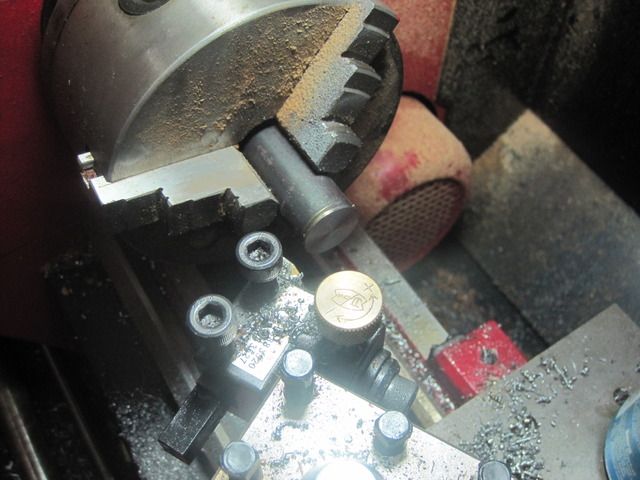
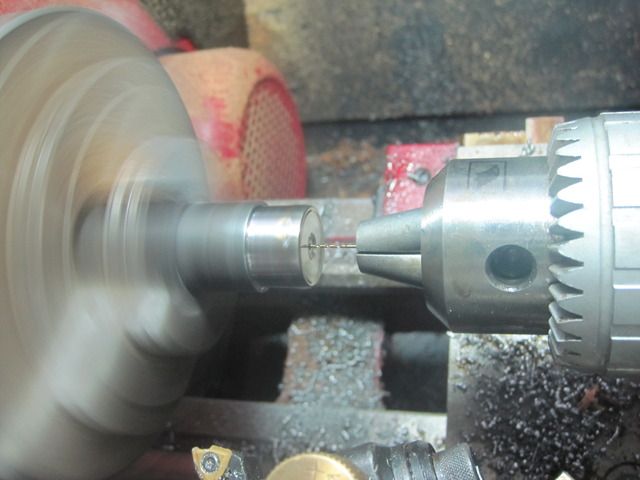
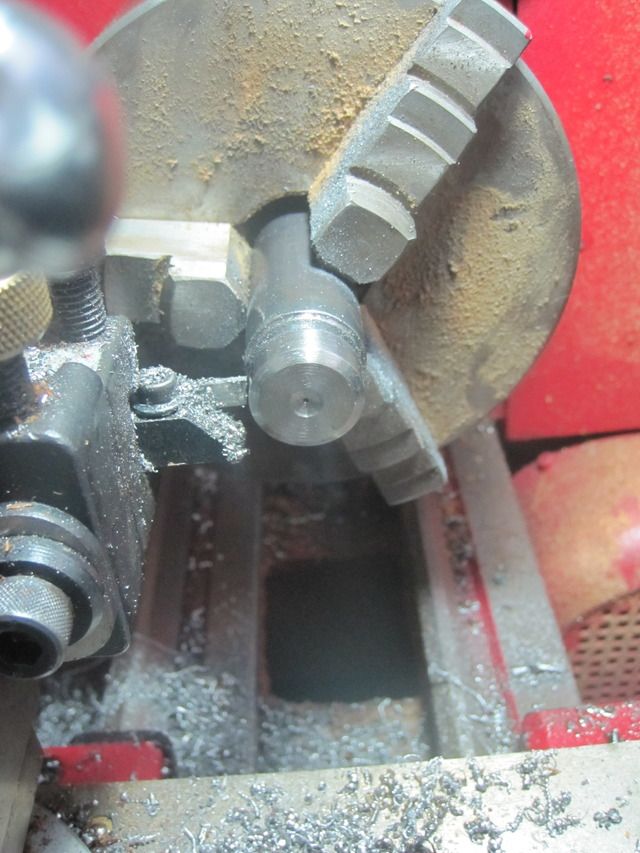
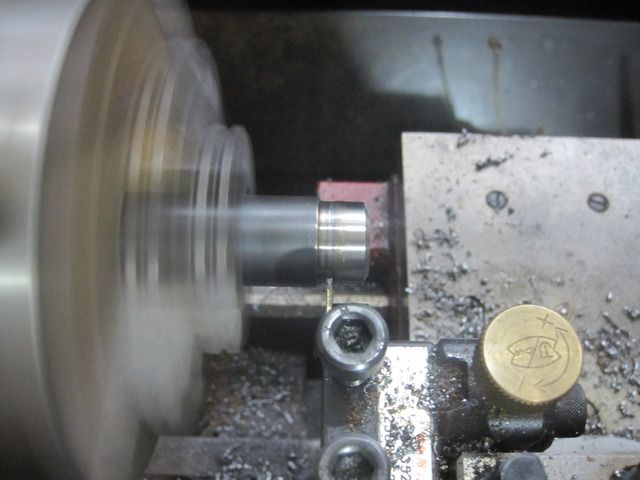
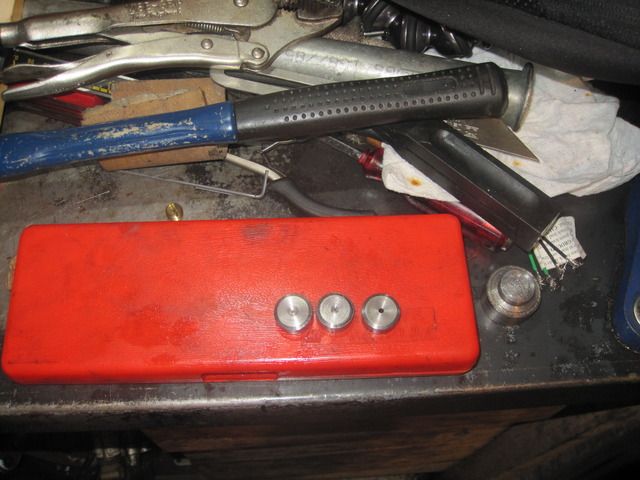
That is the problem with Amsoil.
They also had a .032 orifice on their older single mounts, and a one size fits all .094! No option to size the metering as needed for the engine size or pumps ability.
The Racor units used a .040 orifice.
Some of the TP units used a .0625 orifice.
.050 and .078 were used by other brands.
LuberFiner offered 4 different jets for their LF 500 and 750 housings.
And, some brands used an adjustable metering jet... set by measured oil flow and/or oil pressure loss.
Thanks Greasymechtech for the different orifice sizes. I decided to spend a little time on my lathe and make some Orifice disks for my Amsoil Dual Gard. I thought about just buying them, but what fun is that. lol Sizes I cut are .032" .045" and used .094" as a sample to copy. Here's some pictures:





- Joined
- Jul 11, 2014
- Messages
- 4,118
Now, you should run off a few hundred and sell them to Amsoil.
Great work.
Great work.
Very nice.
- Status
- Not open for further replies.
Similar threads
- Replies
- 35
- Views
- 2K
- Replies
- 2
- Views
- 1K
- Replies
- 14
- Views
- 2K
- Replies
- 14
- Views
- 3K

